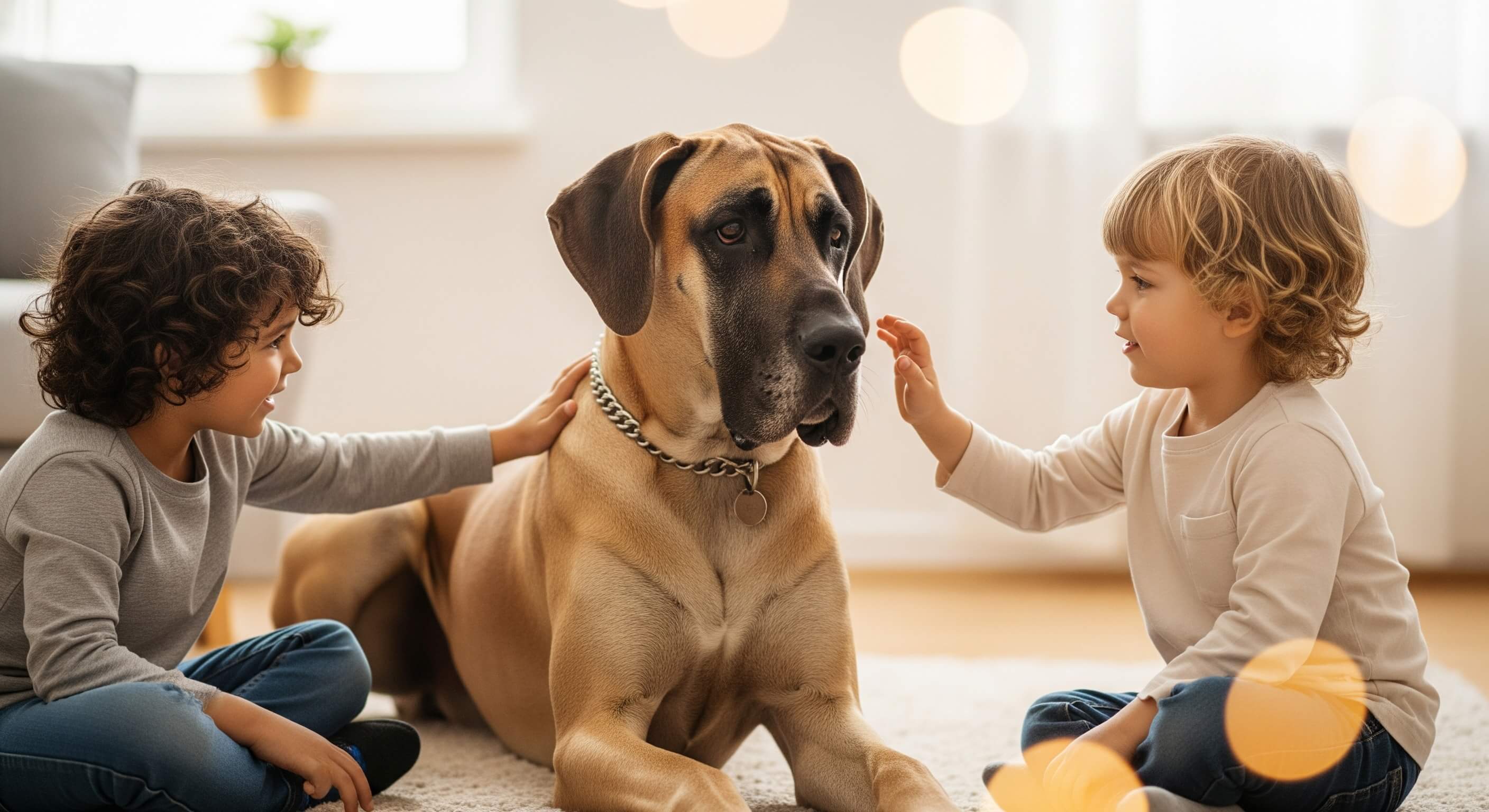Often called the "Apollo of Dogs," the Great Dane is a true gentle giant. Despite their imposing size, these dogs are known for their loving temperament, family-friendly nature, and surprisingly sensitive personalities. If you're considering bringing one into your home—or just fascinated by this majestic breed—this guide is for you.
Temperament & Personality Traits
Great Danes are affectionate, loyal, and often described as "velcro dogs"—they love being close to their humans. Their personality traits include a calm demeanor, patience with children, and a protective but non-aggressive attitude. They're naturally friendly with people and other animals when properly socialized.
Training Difficulty & Socialization Needs
Despite their size, training a Great Dane is not overly difficult if you start early. However, their stubborn streak means consistency is key. They respond well to positive reinforcement, especially when treats or belly rubs are involved. Early socialization needs should focus on exposing them to various environments, people, and pets to prevent shyness or fearfulness later.
Exercise Requirements
While they don’t require intense workouts, Great Danes do need daily walks and playtime to stay fit and stimulated. Their exercise requirements are moderate—aim for two 20–30 minute walks a day, especially during their energetic puppy phase. Avoid strenuous activity before 18 months to protect their growing joints.
Grooming Needs & Shedding Level
Great Danes have short, sleek coats with minimal grooming needs. A weekly brushing helps manage their shedding level, which is low to moderate. Bathing every 6–8 weeks or as needed will keep them smelling fresh. Don’t forget ear cleaning and nail trimming!
Diet Requirements
Feeding a Great Dane properly is critical, especially to avoid gastric torsion (bloat), which they're prone to. Divide meals into 2–3 feedings per day and avoid vigorous activity around mealtimes. Their diet requirements include:
- High-quality large-breed dog food
- Joint supplements (glucosamine, chondroitin)
- Plenty of fresh water
- Low-fat treats for training
Health Issues & Lifespan
Sadly, Great Danes have a relatively short lifespan, typically around 7–10 years. Common health issues include:
- Hip dysplasia
- Gastric torsion (bloat)
- Cardiomyopathy
- Thyroid problems
- Wobbler syndrome
Routine vet checkups, a balanced diet, and joint care can make a big difference in quality of life.
Apartment Living: Is It Possible?
You might be surprised, but Great Danes can thrive in apartment living if exercised regularly. They’re typically couch potatoes indoors and don’t require a yard—though a walkable neighborhood or nearby park is a must.
Family-Friendly & Good with Children
Yes, they’re exceptionally family-friendly and good with children! Great Danes are patient, gentle, and often bond strongly with kids. Just supervise interactions with small children due to their size—accidental bumps can happen!
Barking Tendency
These dogs have a low barking tendency. They usually bark only to alert or out of boredom. A well-exercised, mentally stimulated Dane is a quiet companion.
Summary: Is the Great Dane Right for You?
If you’ve got the space in your heart (and home) for a calm, loving giant, the Great Dane may be your perfect match. Just be ready for drool, big footprints, and even bigger cuddles.
Do's and Don'ts
✅ Do's
- Do: Begin training and socialization early
- Do: Invest in orthopedic bedding
- Do: Monitor their diet to prevent bloat
🚫 Don’ts
- Don't: Allow rough play with small kids or pets
- Don't: Skip daily walks—even if they seem lazy
Recommended Products
- Raised feeding bowls
- Heavy-duty leash and harness
- Large orthopedic dog bed
- Joint supplements (vet-approved)
- Slow-feeder bowls
Owning a Great Dane is a big commitment—literally and figuratively—but the rewards are just as enormous.
Frequently Asked Questions (FAQs)
1. What is the typical lifespan of a Great Dane?
2. Are Great Danes good for first-time dog owners?
3. How much exercise does a Great Dane need?
4. Do Great Danes shed a lot?
5. Can Great Danes live in apartments?
6. What health problems are common in Great Danes?

About SniffnTail
SniffnTail is your go-to destination for everything pets. From helpful advice, tips, and insights to thoughtfully selected products and resources, we’re here to support pet owners at every stage of their journey. Whether you're caring for a playful pup, a wise old cat, or anything in between, SniffnTail offers tools and knowledge to make pet parenting easier and more joyful.
Related Articles
 Dog Breeds • 35-45 minutes
Dog Breeds • 35-45 minutesSussex Spaniel Dog Guide: Comprehensive Veterinary-Approved Care
Unlock the secrets to a healthy, happy Sussex Spaniel with this veterinarian-approved guide. Covering everything from health and nutrition to training and behavior, learn how to provide optimal care for your beloved companion.
 Dog Breeds • 23 min Read
Dog Breeds • 23 min ReadBeauceron Dog Breed Information: Temperament, Health, Training & Care Guide
Learn everything about the Beauceron dog breed from a board-certified veterinarian. This in-depth guide covers Beauceron temperament, health issues, training advice, nutrition, grooming, and more.
 Dog Breeds • 20-25 minutes
Dog Breeds • 20-25 minutesThe Basset Bleu de Gascogne: A Comprehensive Veterinary Guide for Health-Conscious Pet Parents
Unlock the secrets to a thriving Basset Bleu de Gascogne with this in-depth guide from a board-certified veterinarian. Learn about their unique health needs, optimal nutrition, behavior, training, and preventive care strategies, backed by scientific research and over 15 years of clinical experience.

